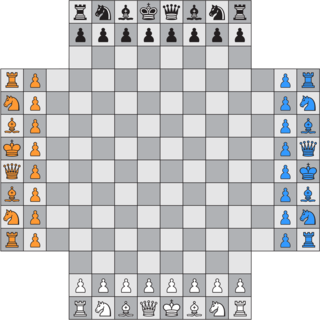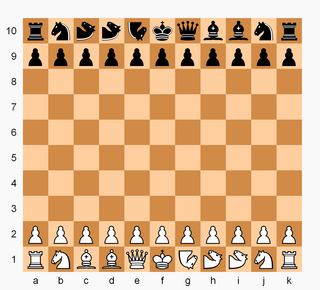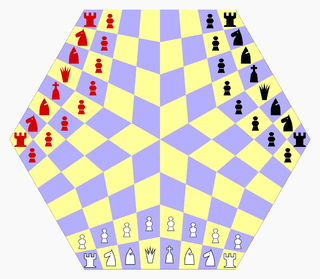Avalanche chess is a chess variant designed by Ralph Betza in 1977. After moving one of their own pieces, a player must move one of the opponent's pawns forward one square.
Losing chess is one of the most popular chess variants. The objective of each player is to lose all of their pieces or be stalemated, that is, a misère version. In some variations, a player may also win by checkmating or by being checkmated.
Martian Chess is an abstract strategy game for two or four players invented by Andrew Looney in 1999. It is played with Icehouse pyramids on a chessboard. To play with a number of players other than two or four, a non-Euclidean surface can be tiled to produce a board of the required size, allowing up to six players.

Sittuyin, also known as Burmese chess, is a strategy board game created in Myanmar. It is a direct offspring of the Indian game of chaturanga, which arrived in Myanmar in the 8th century thus it is part of the same family of games such as chess, and shogi. Sit is the modern Burmese word for "army" or "war"; the word sittuyin can be translated as "representation of the four characteristics of army"—chariot, elephant, cavalry and infantry.
Extinction chess is a chess variant invented by R. Wayne Schmittberger, editor of Games magazine, in 1985. Instead of checkmate as the winning condition, the object of the game is the elimination of all of a particular type of piece of the opponent. In other words, the objective is any of the following:

Four-player chess is a family of chess variants played with four people. The game features a special board typically made of a standard 8×8 square, with 3 rows of 8 cells each extending from each side, and requires two sets of differently colored pieces. The rules are similar to, but not the same as, regular chess. There are a variety of different rule variations; most variations, however, share a somewhat similar board and piece setup.
Checkless chess, also known as prohibition chess, is a chess variant where neither player may give check unless it is checkmate. All other rules are as in regular chess. The origin of the game is unknown, dating from the mid-19th century. The variant is a popular problem theme, usually requiring a fairy mate.
Modern chess is a chess variant played on a 9×9 board. The game was invented by Gabriel Vicente Maura in 1968. Besides the usual set of chess pieces, each player has a prime minister and an additional pawn:
Jeson Mor is a two-player strategy board game from Mongolia. It is considered a chess variant. The game is played on a 9×9 checkered gameboard. Each player has nine chess knights initially lined up on the players' first ranks. A player wins by being first to occupy the central square with a knight, and then leave that square.

Cubic chess is a chess variant invented by Vladimír Pribylinec beginning with an early version in 1977. The game substitutes cubes for the chess pieces, where four of the faces of each cube display a different chess piece, the two other faces are blank and are orientated to the players. This provides an efficient means to change a piece's type. Kings and queens have unique cubes containing only their symbol, effectively behaving as normal.

Wildebeest chess is a chess variant created by R. Wayne Schmittberger in 1987. The Wildebeest board is 11×10 squares. Besides the standard chess pieces, each side has two camels and one "wildebeest" - a piece which may move as either a camel or a knight.

Chad is a chess variant for two players created by Christian Freeling in 1979. It is played on an uncheckered 12×12 gameboard with one king and eight rooks per side, where rooks are able to promote to queens.

Three-man chess is a chess variant for three players invented by George R. Dekle Sr. in 1984. The game is played on a hexagonal board comprising 96 quadrilateral cells. Each player controls a standard army of chess pieces.

Quatrochess is a chess variant for four players invented by George R. Dekle Sr. in 1986. It is played on a square 14×14 board that excludes the four central squares. Each player controls a standard set of sixteen chess pieces, and additionally nine fairy pieces. The game can be played in partnership or all-versus-all.

Beirut chess is a chess variant invented by Jim Winslow in 1992. The game is played using the standard chess pieces and board, with each side having secretly equipped one of their men with a "bomb"—which can be "detonated" at any time, wiping out all men on surrounding squares along with the bomb carrier.

Balbo's game is a chess variant invented by M. [Monsieur] G. Balbo in 1974. The chessboard has a novel shape comprising 70 squares, and each player commands a full chess army minus one pawn.
The Chess Variant Pages is a non-commercial website devoted to chess variants. It was created by Hans Bodlaender in 1995. The site is "run by hobbyists for hobbyists" and is "the most wide-ranging and authoritative web site on chess variants".

Hostage chess is a chess variant invented by John A. Leslie in 1997. Captured pieces are not eliminated from the game but can reenter active play through drops, similar to shogi. Unlike shogi, the piece a player may drop is one of their own pieces previously captured by the opponent. In exchange, the player returns a previously captured enemy piece which the opponent may drop on a future turn. This is the characteristic feature of the game.
Chancellor chess is a chess variant invented by Benjamin R. Foster in 1887. It features all the regular chess pieces plus one chancellor and extra pawn per side, on a 9×9 board.

Triangular chess refers to a group of chess variants played on boards composed of triangular cells.











